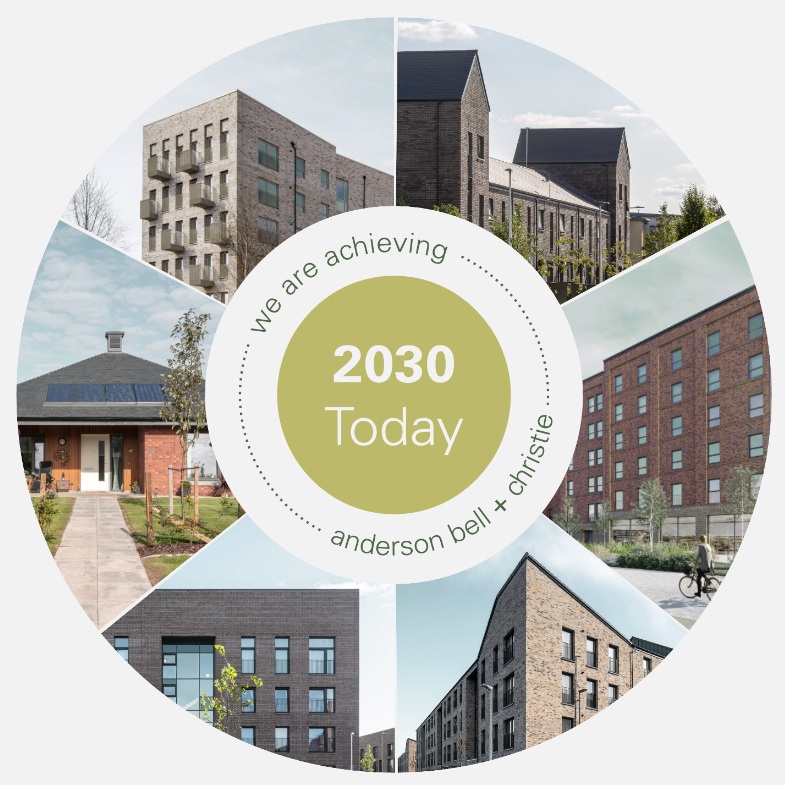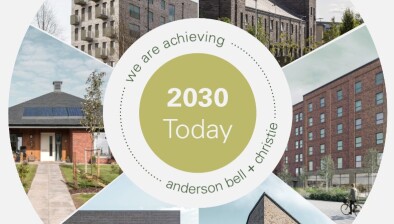Anderson Bell + Christie ‘streets ahead’ on embodied carbon, research finds

Image copyright: Anderson Bell + Christie
New research into the embodied carbon resulting from the homes designed by Anderson Bell + Christie (ABC) has found that they exceed industry 2030 targets, but the practice has called for an urgent and comprehensive plan for Scotland to follow suit.
Embodied carbon is emitted when creating materials, assembling them into buildings and released at end of use. With the transition to grid decarbonisation well underway, alongside the use of zero emissions heat sources in all new homes, embodied carbon now represents most emissions associated with a new building. By 2045, it will be all the emissions.
According to the research, typical Anderson Bell + Christie designs achieve on average 541kgCO2e/m2 for building lifecycle stages A (creating and assembling materials), B (in use) and C (end of life).
Embodied carbon is unregulated in the UK, meaning that there is no national legislation in place to set limits. Instead, there are voluntary targets, put forward by organisations including UK Net Zero Carbon Buildings Standard (UK-NZCBS) and the Royal Institute of British Architects (RIBA). UK-NZCBS targets consider building lifecycle stage A, whereas the RIBA considers lifecycle stages A to C and is therefore more onerous.
RIBA have established a 2025 target of 800kgCO2e/m2 and a 2030 target of 625kgCO2e/m2 for new homes.
ABC director, Jonathan McQuillan, said: “Since the practice was established over 30 years ago our approach has been to deliver high quality placemaking using materials that will stand the test of time. We are delighted to find that this strategy is fundamentally in alignment with low embodied carbon design. The homes we currently design represent around 14% improvement on the 2030 RIBA target.”
This research has however identified the need for wholesale change in the construction industry. A new development of 100 homes, with zero emissions heat systems, when built to ABCs design standard, could still be responsible for a total of 4,399 tonnes of embodied carbon emissions.
To put this in context, the operational carbon (the carbon emitted from heating and powering the dwellings), for the same new 100-home development has been estimated at 258 tonnes CO2e over a 60-year period. In new homes, with zero emissions heat sources, operational carbon is not the main concern. Embodied carbon is currently around 17 times greater than operational carbon in this context.
ABC carbon assessor, Francisco Shankland, said: “It is clear that the elephant in the room is embodied carbon. We believe Anderson Bell Christie are an industry leader in embodied carbon, yet we are extremely concerned by the sheer quantity of embodied carbon emissions associated with new buildings. The industry needs to tackle this urgently.”
Time is not on our side, with only 20 years remaining to the 2045 net zero deadline. Change is a slow process, as demonstrated by the legislative development to regulate operational carbon.
ABC director, Jonathan McQuillan, said: “The Sullivan Report was published in 2007, the same year I became a Chartered Architect. This publication set out a policy roadmap for reducing operational carbon which has been present throughout my career. Now with the Scottish Equivalent to Passivhaus, that journey is coming to an end, it is time to face the next challenge.”
In October 2024, the Scottish Government closed the first round of public consultation on the Scottish Equivalent to Passivhaus, which stated that the preferred option for introducing new Building Standards is early 2028. The legislative process for operational carbon will have taken over 21 years from the publication of the Sullivan Report in 2007 to implementation of the Scottish Equivalent building standards in 2028.
The scale of challenge with embodied carbon is at least commensurate with operational carbon. The practice hopes that the Scottish Equivalent to Passivhaus will draw a line under conversations related to operational carbon.
Jonathan McQuillan added: “Given the scale of the problem, we need to move the dialogue on to embodied carbon. Policy plans for embodied carbon haven’t left the starting blocks. We need a route to reach net zero with embodied carbon by 2045. The construction industry needs to show leadership and help shape legislation with the Scottish Government.
“Anderson Bell + Christie are using their extensive research to develop a roadmap to a holistic net zero position by 2045 that will address embodied carbon. We look forward to presenting this to the Scottish Government in early 2025. We only have 20 years to tackle this problem from scratch, given the timescales involved with legislative change, we need to start now.”















